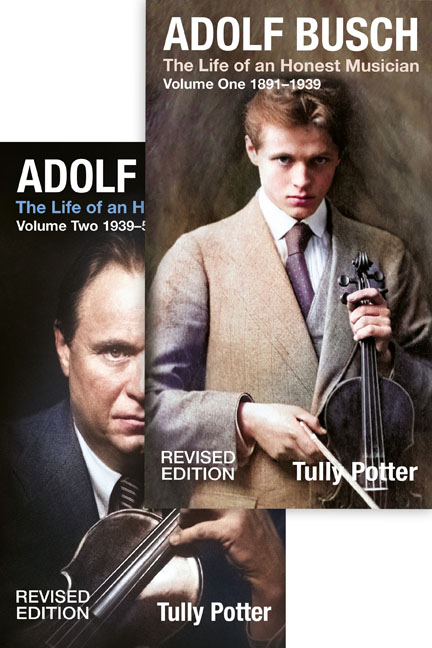Book contents
- Frontmatter
- Contents
- Illustrations
- Dedication
- Introduction
- Acknowledgements
- I The Busch Family
- II The Prodigy
- III The Cologne Conservatory
- IV The Young Virtuoso
- V The Vienna Years
- VI Berlin and Busoni
- VII The Darmstadt Days
- VIII Burgeoning in Basel
- IX The Break
- X Busch the Man
- XI The Chamber Players
- XII The Lucerne Festival
- Volume Two: 1939–52
- XIII The New World
- XIV Between Two Continents
- XV The Marlboro School of Music
- Appendices
- Envoi: Erik Chisholm talks about Adolf Busch
- Select Bibliography
- Index to Discography
- Index of Busch’s Compositions
- General Index
- Index to Adolf Busch’s Compositions on Record
- Index to Discography
- Frontmatter
- Contents
- Illustrations
- Dedication
- Introduction
- Acknowledgements
- I The Busch Family
- II The Prodigy
- III The Cologne Conservatory
- IV The Young Virtuoso
- V The Vienna Years
- VI Berlin and Busoni
- VII The Darmstadt Days
- VIII Burgeoning in Basel
- IX The Break
- X Busch the Man
- XI The Chamber Players
- XII The Lucerne Festival
- Volume Two: 1939–52
- XIII The New World
- XIV Between Two Continents
- XV The Marlboro School of Music
- Appendices
- Envoi: Erik Chisholm talks about Adolf Busch
- Select Bibliography
- Index to Discography
- Index of Busch’s Compositions
- General Index
- Index to Adolf Busch’s Compositions on Record
- Index to Discography
Summary
Most violinists, when they essay playing the viola, have to use a smallish instrument and hence produce a modest tone. Busch was big enough in physique and had a sufficiently wide hand-stretch to manage quite a large viola, such as the ‘Paganini’ Strad on which he several times performed Harold in Italy. Another viola he occasionally played was the bastard instrument, owned by the Viennese collector Wilhelm Kux, which had begun life in 1715 as a Stradivari viola d’amore. Throughout his career, he owned violas: his father made him at least two; his father-in-law Hugo Gruters gave him one; he acquired an excellent 1783 Giovanni Battista Guadagnini; and in 1934 he bought Dea Gombrich a Vincenzo Panormo for £103. That year Fritz Baumgartner built him an instrument to order. He even kept a viola pomposa, constructed by Wilhelm Busch, and played it occasionally. His training at the Cologne Conservatory included a certain amount of viola-playing; and he appeared several times as violist of the Gurzenich Quartet. But those were the days when German orchestral musicians called the Bratsche the ‘Penzioninstrument’, as William Primrose pointed out:
When considered too old, too decrepit, or too immoral to play the violin (and heaven knows that takes a bit of doing), the violinist was relegated to scrape out the winter of his discontent as a violist.
Busch shared this rather denigratory view. ‘Only lazy violinists play the viola’, he would say;6 and he sometimes betrayed a casual attitude towards the instrument in his choice of violists. Violinists in the Chamber Players were expected to double on the viola, regardless of whether they had any special feeling for it – in the Sixth ‘Brandenburg’ Concerto, Busch used four or even five players for each of the two solo viola da braccio parts. Blanche Honegger, who had never studied the viola but would happily switch from violin to viola and back again during the course of an evening – she did so in all the concerts of the Trio Moyse – was his kind of musician. He would have endorsed her comment: ‘If you can play the violin, you don't have any difficulty playing the viola’.
- Type
- Chapter
- Information
- Adolf BuschThe Life of an Honest Musician, pp. 1015 - 1020Publisher: Boydell & BrewerPrint publication year: 2024



